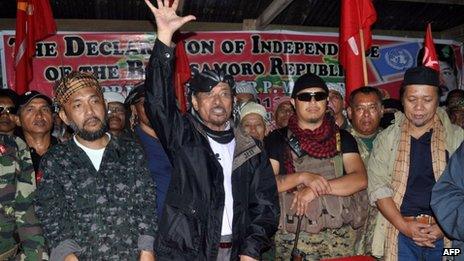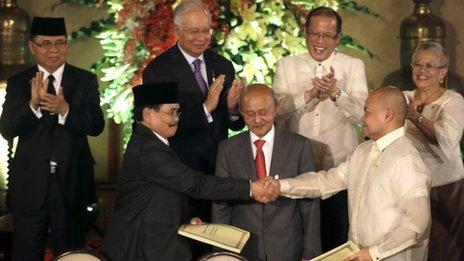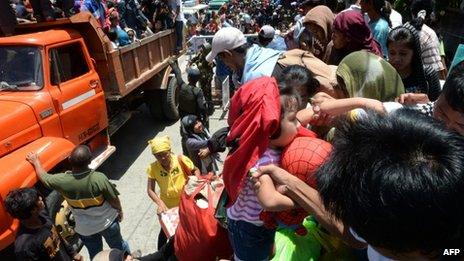What is behind the fighting in the Philippines' Zamboanga?
- Published

Philippine troops continue to battle insurgents in Zamboanga city on Friday
Zamboanga is the sixth largest city in the Philippines, and a vital hub for the economy of the south. For the past five days, it has been more or less shut down by a confrontation between the army and a group of insurgents from the Moro National Liberation Front (MNLF).
Yet the MNLF, the group that started its armed campaign against the central government back in the early 1970s, was also the first to make peace, in 1996.
After that, its leader, Nur Misuari, was the governor of an autonomous region for five years. So why did his followers land in Zamboanga, heavily armed, and then take over several districts of the city?
The Misuari issue
The insurgents, numbering around 180, are believed to be led by Habier Malik, a veteran MNLF commander who has been involved in many other armed attacks in the past, including a similar one in Zamboanga 12 years ago.
He is known to be a loyal supporter of Nur Misuari, but according to the government the MNLF leader has denied authorising this latest operation.
For their part, the MNLF gunmen in Zamboanga have said they are fighting for an independent state, not the autonomy the government is negotiating with the larger MILF insurgent group.
The Philippine military still believe Nur Misuari is responsible, and the authorities are considering laying criminal charges against him, although his exact whereabouts are unknown.

The current whereabouts of Nur Misuari (centre) are uncertain
The MNLF's strongholds are in the Sulu archipelago, a sprawling stretch of islands south-west of Zamboanga, where the government's authority is weak, so finding him would be difficult.
This all has striking echoes of the situation 12 years ago. Back then Nur Misuari had announced that he was taking up arms against the government again, after he was ousted as chairman of the MNLF and it split into rival factions.
In November 2001, his men attacked military bases on the island of Jolo. After that, clashes in Zamboanga between the military and some of his forces, who had been allowed to remain there under the 1996 deal, ended with the MNLF taking all of the inhabitants of a nearby neighbourhood hostage, and marching them, roped together, through the streets of the city, until they were allowed to leave.
'Sense of entitlement'
Nur Misuari fled to Malaysia, from where he was extradited back to the Philippines and charged with rebellion. He was eventually released, and the charges dropped seven years later.
At the heart of this particular fight - among several armed conflicts in the southern Philippines - is Nur Misuari's "sense of entitlement", as the government describes it, and his steady marginalisation from the wider peace process.
The Muslims of the south call themselves the Moro people, and they have been rebelling against the central government for centuries.
During the 1970s, Nur Misuari established himself as the pre-eminent leader of the MNLF, and was recognised as the Moro representative by the 57-member Organisation of the Islamic Conference, which has played a prominent role in trying to end the conflict.
The first serious blow to Misuari's authority was the split in 1978, which led to the establishment of the MILF, based on the main island of Mindanao rather than in the Sulu archipelago.

The government and the MILF agreed on a ceasefire last year
The MILF refused to negotiate with the government, so then-President Fidel Ramos turned to Nur Misuari to negotiate the landmark 1996 agreement, creating the Autonomous Region in Muslim Mindanao (ARMM), which was intended to be a pre-cursor to a more permanent autonomy deal.
But five years later the deal had soured, with Nur Misuari facing widespread criticism over poor leadership and corruption. His supporters blamed the government for failing to give sufficient assistance and funding to run the impoverished and war-damaged ARMM.
Nonetheless he was voted out of the MNLF chairman's seat. The movement is now divided into three main factions, although much of its armed wing remains loyal to Misuari.
Territorial fighting
The situation is complicated by the presence of so many other armed groups and warlords in this region.
There is the militant Islamic group Abu Sayyaf, notorious for kidnapping and murder, and partly comprised of disaffected MNLF fighters. There is the Bangsamoro Islamic Freedom Fighters group, which split from the MILF during its negotiations with the government. There are also so-called "lost commandos" - fighters who are not members of any group, but may join battles for either profit or principle.

Villagers in the areas affected by the current fighting have fled to safety
So long as the peace talks remained stalled, as they did for most of the past decade, the various groups operated on their own turf, and the army did little to disturb the status quo.
The exception was Abu Sayyaf, which was hit hard in an operation supported by the US military because of its links to al-Qaeda.
But last year the government and the MILF announced a breakthrough in their talks, and signed a ceasefire. In recent months they have made progress in negotiating power and revenue-sharing.
Government officials have made it clear in their comments that they no longer regard Nur Misuari as a negotiating partner. The MILF is a larger group, and has been the tougher opponent in recent years. The hope is clearly that if the peace deal holds, most of the MNLF factions will want to jump on board to make sure they get their share of the benefits.
Nur Misuari has responded with growing indignation, accusing the government of betraying the agreement it signed back in 1996. But even when he dramatically declared an independent Bangsamoro state last month, he promised he would pursue it through peaceful means.
The government will have to decide now whether he authorised the attack on Zamboanga, and what they do with him. None of the other MNLF factions has supported him; he appears isolated.
But excluding him altogether may prove counterproductive, if it reignites the conflict just as a lasting peace seems within reach.
- Published12 September 2013
- Published12 September 2013
- Published11 September 2013
- Published14 February 2013
- Published8 October 2012